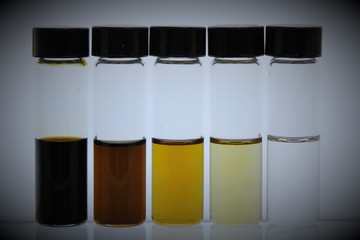Tavakkoli and Vargas (2015) developed a new method to determine the onset of asphaltene precipitation, which is much more sensitive than current commercial techniques. In this method, which was published by Tavakkoli et al. (2015), asphaltene precipitation is detected indirectly. After the different blends of crude oil and precipitant are prepared, and certain time has elapsed to allow asphaltenes aggregates to form, the samples are centrifuged at about 10,000 relative centrifuge force for 15 minutes, which is enough to settle particles as small as 100 nm. The separation of these particles, in turn, affects the absorbance of the supernatant fluid, which can be determined in the visible region of the light spectrum, at 700 nm, or in the NIR region, at 1,100 nm. After removing the effect of dilution caused by the addition of n-heptane (and toluene that is added to stabilize asphaltenes and decrease the darkness of the sample), the absorbance of the different samples can be plotted as a function of the volume % of n-heptane. Figure 1 shows the results of this method applied to a model oil system (0.5 wt% of asphaltenes extracted from crude oil from Middle East in toluene).
According to this method, this particular oil requires the addition of 42 volume % of n-heptane to start the precipitation of asphaltenes at ambient temperature. Figure 1 also shows the excellent reproducibility of this technique. The average standard deviation (ASD) for this set of experiments is about 2 %.
The indirect method for asphaltene precipitation detection is much more sensitive than the conventional techniques based on direct determination of the presence of asphaltene aggregates (e.g. NIR light scattering), as it is shown in Figure 2. For the same model oil system, the indirect method reports an onset of precipitation of 38 volume %, whereas the direct observation of aggregates reports 44%.
 Figure 1. Determination of the onset of asphaltene precipitation in a model oil system (0.5 wt% Middle East asphaltenes in toluene), using the indirect method at ambient temperature. |
 Figure 2. Onsets of asphaltene precipitation determined by the new indirect method and the conventional direct method for a model oil (0.5 wt% Middle East asphaltenes in toluene), at ambient temperature. |
The indirect method has been successfully applied to real crude oil systems, with asphaltene contents ranging from 0.2 wt % to 10 wt %. Other advantages of this method include its ability to incorporate the analysis of the effect of water and electrolytes on asphaltene stability and to give an indication of the amount of asphaltene precipitated, not only the onset of precipitation.
References
- Tavakkoli, M., Grimes, M. R., Liu, X., et al. (2015). Indirect Method: A Novel Technique for Experimental Determination of Asphaltene Precipitation. Energy & Fuels, 29 (5), 2890–2900.








